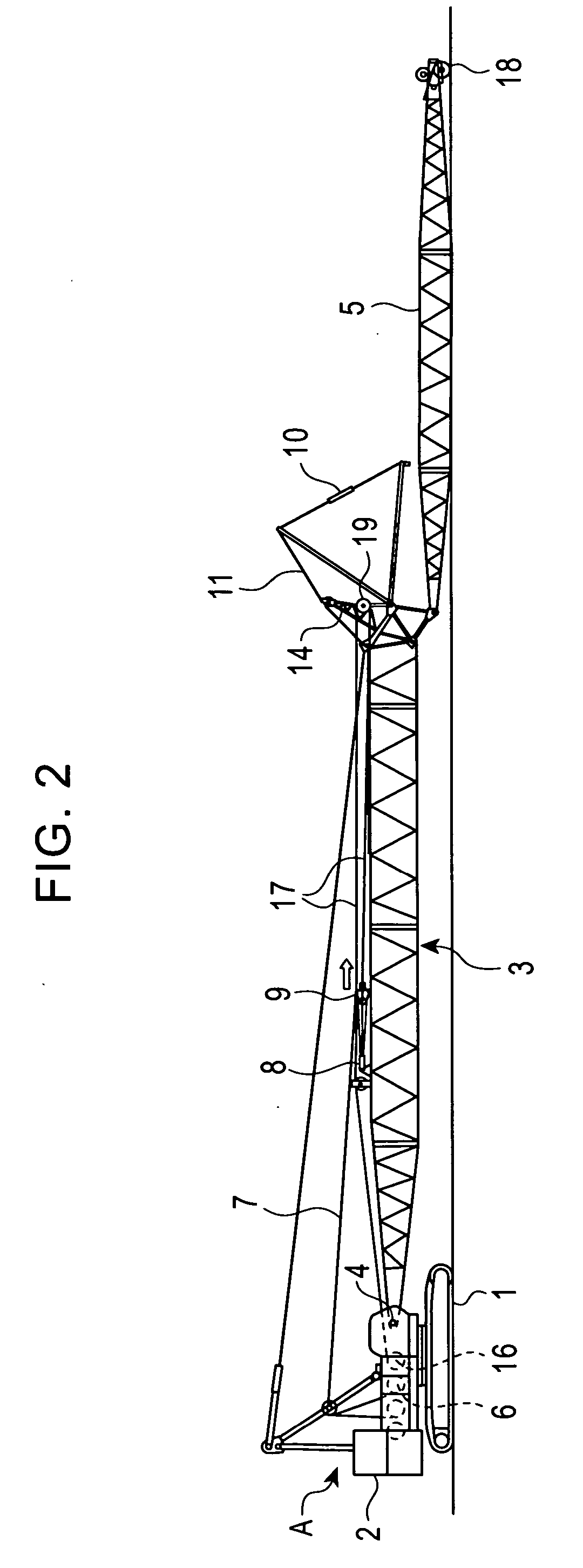Traveling crane and assembling/disassembling method thereof
a technology of travel cranes and support legs, which is applied in the direction of cranes, etc., can solve the problems of physical facilities breaking, disadvantages in operating efficiency and cost overrun due to additional sheave, and weight in the vicinity of the boom end (around the strut), so as to avoid the interference between the obstacles and the support legs
- Summary
- Abstract
- Description
- Claims
- Application Information
AI Technical Summary
Benefits of technology
Problems solved by technology
Method used
Image
Examples
first embodiment (see figs.1 to 9)
First Embodiment (See FIGS. 1 to 9)
[0049]FIG. 1 shows an operation state (assembled state) of a traveling crane according to the present invention; FIGS. 2 to 7 show the procedure of assembling / disassembling of the crane.
[0050] In the drawings, on a crawler lower traveling body 1, an upper rotating body 2 is revolvably mounted so as to constitute a base machine A therewith. On the upper rotating body 2, a boom (may also be called as a tower depending on a specification) 3 is derrickably mounted so as to be raised and lowered with a boom foot bin 4 as a derricking fulcrum. At a far end of the boom 3, a jib 5 is derrickably attached.
[0051] In addition, there may be a crane that is operated by derricking both the boom 3 and the jib 5; the present invention may incorporate a traveling crane of this type.
[0052] Fundamentally, in a state that the boom 3 is maintained at a predetermined angle, the crane is operated by derricking the jib 5 (in a luffing crane, the boom 3 is also derricke...
second embodiment (see fig.10)
Second Embodiment (See FIG. 10)
[0096] According to the first embodiment, the operation is restricted only in the direction that the tension of the jib derricking rope 7 increases. Conversely, the excessively decreased rope tension may cause the irregular winding, so that it is desirable that the operation be restricted also in the direction that the rope tension decreases.
[0097] The control according to a second embodiment having these two functions will be described with reference to FIG. 10.
[0098] It is determined: at Step S11, whether an assemble / disassemble mode is selected or not; at Step S12, whether the boom angle is the angle during the assembling / disassembling or not. Then, at Step S13, it is determined whether simultaneous operations of the rewinding of the jib derricking rope and the winding of the hook hoisting rope is carried out based on signals from the pressure sensors 32 and 33 shown in FIG. 8 or not. Thereafter, the operation in the direction that the rope tensio...
third embodiment (see figs.11 to 15a)
Third Embodiment (See FIGS. 11 to 15A)
[0111] An upper spreader 9′ structured differently from that according to the embodiments described above and a structure for moving the upper spreader 91 between the boom anchor and the leading end of the boom will be described with reference to FIGS. 11 to 14. On the other hand, structures common to the embodiments described above will be described with reference to the above-mentioned figures.
[0112] Along a predetermined section within between the anchor of the boom 3 and the leading end thereof, a lateral pair of rails 190 and 190 are provided on the boom upper surface.
[0113] Both the respective rails 190 and 190 are formed in a closed section having a horizontal upper surface, such as a square steel pipe.
[0114] On the other hand, the upper spreader 9′ is integrally composed of a vertical sheave block 220 having a plurality of (two in the drawing) vertical sheaves 210 and 210 rotating about a horizontal sheave shaft 200 and a horizontal s...
PUM
 Login to View More
Login to View More Abstract
Description
Claims
Application Information
 Login to View More
Login to View More - R&D
- Intellectual Property
- Life Sciences
- Materials
- Tech Scout
- Unparalleled Data Quality
- Higher Quality Content
- 60% Fewer Hallucinations
Browse by: Latest US Patents, China's latest patents, Technical Efficacy Thesaurus, Application Domain, Technology Topic, Popular Technical Reports.
© 2025 PatSnap. All rights reserved.Legal|Privacy policy|Modern Slavery Act Transparency Statement|Sitemap|About US| Contact US: help@patsnap.com



